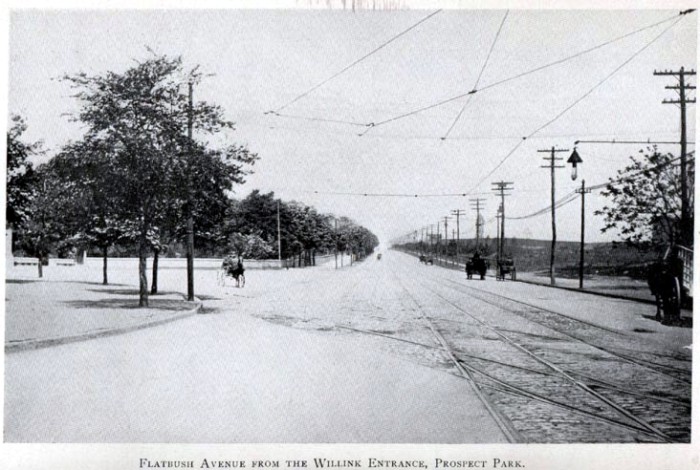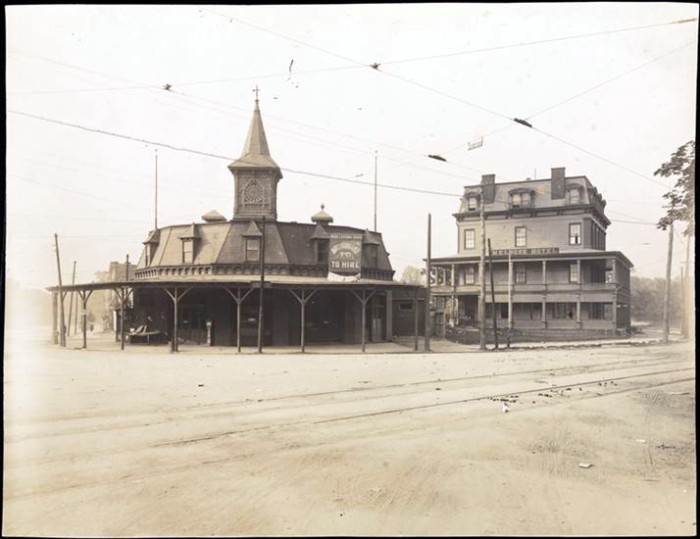Walkabout: Mayhem and Murder at the Melrose
Read Part 2 of this story. A photograph of an old way station with a hotel in the background was the inspiration for another column a little while ago. That turn of the 20th century photograph was taken of the old BF&CI train depot and Sutter’s Melrose Hotel, both located on the turn of Ocean…


Read Part 2 of this story.
A photograph of an old way station with a hotel in the background was the inspiration for another column a little while ago. That turn of the 20th century photograph was taken of the old BF&CI train depot and Sutter’s Melrose Hotel, both located on the turn of Ocean Avenue, as it begins its path at Flatbush, right at the Flatbush end of Prospect Park. The old railroad was the precursor of today’s B and Q trains, and once took day trippers to Coney Island.
The Melrose Hotel was a popular place for tourists and businessmen to spend the night, and also served the local community as an event space. Both are long gone and forgotten. The hotel was a former mansion, the home of the wealthy and reclusive Willink family. They would be totally forgotten as well, had not the nearby entrance to the park been named for them. This entire area was once a part of their large estate. The full story of the Willink family and how the mansion became a hotel was related in this Past and Present column.
In researching the hotel, it soon became apparent that quite a lot of events had taken place there. Sutter’s Melrose Hotel was not all that large, but was a hotbed of activity. Most of it was unremarkable ordinary fare, and the hotel was well known for all the right reasons, but as it aged, it began to become one of those places where bad people came to do their dirty deeds. Of course, just like today, those events became front page fodder for a voracious daily press. In the early years of the 20th century, mayhem and even murder were frequent guests at Flatbush’s Melrose Hotel.
It seems a bit incongruous that this former mansion could hold as many guests as it did. We’ll never know how it was arranged, if the rooms were re-sized or reconfigured for guests. From the many articles in the papers, in addition to overnight lodging, the Melrose was a popular meeting place for local organizations and for groups of people celebrating birthdays or other special occasions.
It would stand to reason that the entire parlor floor was turned over to guests for this purpose. The hotel had to have a reception area, and at least two other large rooms for dining and/or meeting. With office space for the manager, and perhaps a library/game room, I would imagine most of that floor was public space. Upstairs, the top three floors would have accommodated guests.
In the early 1890s, the Melrose was headquarters for the Prospect Harriers, a running club. They rented a suite of rooms from which they organized their training for races. The club met at the Willink entrance of the park and ran through the park. They returned to the Melrose to rest and clean up. The Harriers liked to organize “moonlight runs” at midnight.
They had several of these during the summer of 1892. Over fifty runners participated. The hotel was also the New York home and training location for several professional boxers who also used the park as training ground when they were in the city. One in particular, Jack Skelly, liked to have his trainer rent a horse and wagon from the hotel, and would run through the park while his trainer drove beside him shouting encouragements.
Like just about every hotel on earth, the Melrose was a place for well-planned assignations. Whereas today, two people can check into a hotel room without having to answer a lot of personal questions as to the nature of their relationship, respectable Victorian hotels prided themselves on the morality of their businesses and of their clients. If people were caught having affairs in their hotels, it reflected badly on the hotel, so they did what they could to nip that sort of thing in the bud. But, of course, it happened all the time.
Dr. Erastus Otis Houghton of 179 Park Place, Brooklyn found that out in 1903. His marriage to Elinor Storm had ended that spring; after he found out she was having an affair with a man named Louis Clayton. Clayton lived in a boarding house at 6th Avenue and St. Johns Place. Suspicious of his wife’s activities, Dr. Houghton had hired a private investigator to follow her.
One night, the investigator took Dr. Houghton and the sexton from his church with him to the Melrose Hotel. They knocked on the door of a room there, and a young man opened the door. The investigator pushed his way in, and Mrs. Houghton was lying in the bed. “Is this your wife, sir?” the investigator asked. “Yes.” Dr. Houghton replied. The judge granted him an unconditional divorce.
Apparently the good doctor was not done with the couple. Less than three months later, in August, he found out that his ex-wife and Clayton had gotten married in Greenwich, Ct. He reported them to the authorities and had them arrested. The law stated that one could not re-marry until three months had passed after a divorce had been granted. They were a couple of weeks short. A man scorned can be quite vindictive, too. The papers noted that Dr. Houghton had sold his Park Slope house, and was moving to California.
In February of 1909, a man named Harry C. Pope checked into the Melrose Hotel. He was in the company of a young lady named Bessie Schroeder. Harry was thirty-three years old, and was married, although he had been separated from his wife for over four years. Before he had met and married his wife, he had been dating Miss Schroeder. However, for some reason, they broke up. He met his wife, Emma, and they married. But it wasn’t a happy union, and only a few years later, they separated. Harry went back to the love of his life, Bessie.
Harry was from a wealthy family in Williamsburg. His father had been a prominent lawyer there, and owned a lot of property in that section of Brooklyn. His father had died ten years before, and his mother and his mother and sister had moved to New Jersey, where they were both quite well off. Apparently, Harry had not made wise choices with his inheritance. He had gone to Alaska to make his fortune there, but came back empty handed and broke. He tried being a wine wholesaler, but that wasn’t working for him either, so he and a partner opened up a saloon.
As an aside, it’s interesting to see how the different papers that covered this story talked about the saloon. The more sensational Manhattan papers called it a saloon, the Brooklyn Eagle referred to it as a liquor establishment. At any rate, in spite of his financial problems, Harry was a very popular guy, with a lot of friends and admirers. He was active in local Bushwick politics and had organized a political club for himself, the Harry C. Pope Association. The week before he and Miss Schroeder checked into the Melrose, they had thrown a party at the Association, and Harry and Bessie had promenaded together during the entire event. They were quite the couple.
Needless to say, Bessie’s mother and family were not as enthused about Harry Pope as Bessie was. They didn’t like him at all. Mrs. Schroeder especially didn’t like that he was still technically married while escorting her daughter around town and cavorting with her in public. Harry had told Bessie that he no longer loved Emma, and wanted a divorce, so that he could marry Bessie. The girl’s mother was not impressed, and she refused to allow Harry to call on her at the house, and told both of them they were not to see each other. Of course, that only made them sneak off and see each other even more. Neighbors reported seeing them together all the time.
That Saturday in February, 1909, Mrs. Schroeder saw her daughter in the morning. Bessie told her that she was going out to look for a job, most likely in retail, and would be home later. She lied. She went out and met Harry. A day later, they arrived at the Melrose Hotel. Harry was in a fine suit, carrying a cane, and looked quite prosperous. Bessie was a beautiful girl, and was also well dressed and attracted a great deal of attention. The couple sat down in the dining room and ordered a large meal. Harry then checked in as “Harry C. Pope and wife,” and the couple went upstairs.
They didn’t come out of their room for a couple of days, ordering room service. That Wednesday evening, Harry called room service again, and ordered a large dinner for two. The meals were delivered, around 10 in the evening, but were only half eaten. What happened next in this small Flatbush hotel would make headlines in all of the New York papers. The story will conclude next time. GMAP
(View north up Flatbush Avenue from Willink Entrance to Prospect Park. The Botanical Gardens would be built on the right, but not for a few more years. Photo, late 1890s, via Bridge and Tunnel Club)






Darn! What a cliff-hanger! I’m waiting for the ‘murder’ part of this story- please tell me that’s what’s coming…
I think you should option the rights to this by-line as a TV show. It should follow Downton Abbey in the Sunday night line up on PBS.